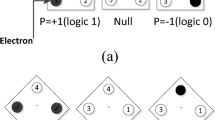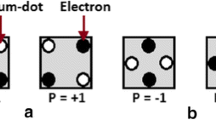Abstract
In today’s technology, optical networking plays a vital role in reducing data losses, thereby providing higher data rates between the transreceivers. The very large scale integration circuits in the modulator–demodulator (MODEM) usually fabricated using complementary metal oxide semiconductor (CMOS) technology have serious scaling limitations; hence, device scaling beyond 65 nm technology becomes highly challenging. Quantum-dot cellular automata (QCA) is one of the most promising nanotechnologies that enable areas of smaller size, i.e. 60% less design area than the CMOS technology, with capability to produce high speed by taking less cycles compared with the other CMOS designs to reduce scaling issues. The QCA-based designs are considered as the best alternative solutions to the transistor-based (CMOS) designs. This paper deals with the implementation of the logic gates NOT, AND, OR, NAND, NOR, XOR and XNOR using both CMOS and QCA technologies, while the QCA allows more possible design structures for each logic gate to enable optimization of the area. Finally, the proposed QCA-based logic gate design and CMOS-based designs are compared in terms of the design area, cell count and the speed of the designs. QCA designer 2.0.3 and virtuoso CADENCE Computer-Aided Design tools are used for carrying out the work.
















Similar content being viewed by others
References
M.A. Amiri, S. Mirzakuchaki, M. Mahdavi, A5/1 Implementation in quantum cellular automata. Nanosci. Nanotechnol. 1(2), 58–63 (2011). https://doi.org/10.5923/j.nn.20110102.11
P.Z. Ahmad, F. Ahmad, H. Ahmad Khan, A new F-shaped XOR gate and its implementations as novel adder circuits based quantum-dot cellular automata (QCA). IOSR J. Comput. Eng. 16(3), 110–117 (2014)
A.L. Bahar, S. Waheed, N. Hossain, Md Asaduzzaman, A novel 3-input XOR function implementation in quantum dot-cellular automata with energy dissipation analysis (Alex. Eng. J., February, 2017)
S. Baskar, V.R. Dhulipala, Implementation of elliptical curve point multiplication over galois field (GF (p)) in 45 nanometer technology. Sens. Lett. 16(8), 632–641 (2018)
S. Baskar, V.R. Dhulipala, Biomedical rehabilitation: data error detection and correction using two dimensional linear feedback shift register based cyclic redundancy check. J. Med. Imaging Health Inform. 8(4), 805–808 (2018)
S. Baskar, V.R. Dhulipala, M-CRAFT-modified multiplier algorithm to reduce overhead in fault tolerance algorithm in wireless sensor networks. J. Comput. Theor. Nanosci. 15(4), 1395–1401 (2018)
S. Baskar, Error recognition and correction enhanced decoding of hybrid codes for memory application, in 2014 2nd International Conference on Devices, Circuits and Systems (ICDCS) (IEEE, 2018), pp. 1–6
M. Beigh, M. Mustafa, F. Ahmad, Performance evaluation of efficient XOR structures in quantum-dot cellular automata (QCA). J. Sci. Res. 4, 147–156 (2013)
E.P. Blair, C.S. Lent, Quantum-dot cellular automata: an architecture for molecular computing, in IEEE conference on Nano Electronics, QCA Designer, (2003), pp. 14–18. www.atips.ca/projects/qcadesigner
A. Chaudhary, D.Z. Chen, X.S. Hu, M.T. Niemier, R. Ravichandran, K. Whitton, Fabricatable interconnect and molecular QCA circuits. IEEE Trans. Comput. Aided Des. Integr. Circuits Syst. 26(11), 1978–1991 (2007)
J. Huang, M. Momenzabeh, M.B. Tahoori, F. Lombardi, Design and Characterization of an And-Or-Inverter (AOI) Gate for QCA Implementation. Dept of Electrical and Computer Engineering Northeastern University Boston, (2015)
H.S. Jagarlamudi, M. Saha, P.K. Jagarlamudi, Quantum dot cellular automata based effective design of combinational and sequential logical structures. World Acad Sci. Eng. Technol. 60, 671–675 (2011)
Y.B. Kim, Challenges for nanoscale MOSFETs and emerging nano electronics. Trans. Electr. Electronic Mater. 11(3), 93–105 (2010). https://doi.org/10.4313/TEEM.2010.11.3.093
K. Kim, K. Wu, R. Karri, The robust QCA adder designs using composable QCA building blocks. IEEE Trans. Comput. Aided Des. Integr. Circuits Syst. 26, 176–183 (2007)
C.S. Lent, P.D. Tougaw, Lines of interacting quantum-dot cells: a binary wire. J. Appl. Phys. 74(10), 6227–6233 (1993)
C.S. Lent, P.D. Tougaw, W. Porod, G.H. Bernstein, Quantum cellular automata. Nanotechnology 4(1), 49 (1993)
C.S. Lent, P.D. Tougaw, A device architecture for computing with quantum dots. Proc. IEEE 85, 541–557 (1997)
M. Liu, C.S. Lent, Bennett and Landauer clocking in quantum-dot cellular automata, in 10th International Workshop on Computational Electronics (IWCE-10) (2004), pp. 120–121. https://doi.org/10.1109/iwcse.2004.1407356
A. Roohi, R.F. Demara, N. Khoshavi, Design and evaluation of an ultra-area-efficient fault-tolerant QCA full adder. Microelectron. J. 46, 531–542 (2015)
S.S. Roy, C. Mukherjee, S.Panda, A.K. Mukhopadhyay, B. Maji, Layered T Comparator design using quantum-dot cellular automata, in 2017 Devices for Integrated Circuit (DevIC), 23–24 March, Kalyani, India (2017).
B. Sen, M. Dutta, M. Goswami, B.K. Sikdar, Modular design of testable reversible ALU by QCA multiplexer with increase in programmability. Microelectron. J. 45, 1522–1532 (2014)
B. Sen, M. Dutta, R. Mukherjee, R.K. Nath, A.P. Sinha, B.K. Sikdar, Towards the design of hybrid QCA tiles targeting high fault tolerance. J. Comput. Electron. 15, 429–445 (2015). https://doi.org/10.1007/s10825-015-0760-7
B. Sen, M. Goswami, S. Mazumda, B.K. Sikdar, Towards modular design of reliable quantum-dot cellular automata logic circuit using multiplexers. Comput. Electr. Eng. 45, 42–54 (2015)
P.D. Tougaw, C.S. Lent, Logical devices implemented using quantum cellular automata. J. Appl. Phys. 75, 1818–1825 (1995). https://doi.org/10.1063/1.356375
K. Walus, T.J. Dysart, G.A. Jullien, R.A. Budiamn, QCA Designer: a rapid design and simulation tool for quantum-dot cellular automata. IEEE Trans. Nanotechnol. 3, 26–31 (2004)
R. Zhang, K. Walus, W. Wang, G.A. Jullien, A method of majority logic reduction for quantum cellular automata. IEEE Trans. Nanotechnol. 3(4), 443–450 (2004). https://doi.org/10.1109/TNANO.2004.834177
Author information
Authors and Affiliations
Corresponding author
Additional information
Publisher’s Note
Springer Nature remains neutral with regard to jurisdictional claims in published maps and institutional affiliations
Rights and permissions
About this article
Cite this article
Hariprasad, A., Ijjada, S.R. Quantum-Dot Cellular Automata Technology for High-Speed High-Data-Rate Networks. Circuits Syst Signal Process 38, 5236–5252 (2019). https://doi.org/10.1007/s00034-019-01119-9
Received:
Revised:
Accepted:
Published:
Issue Date:
DOI: https://doi.org/10.1007/s00034-019-01119-9




